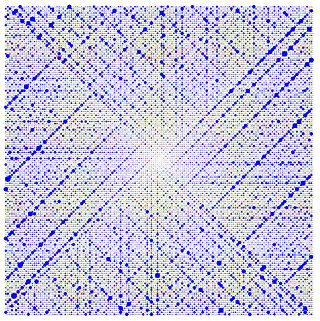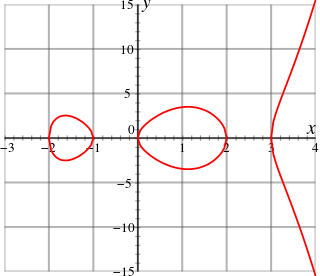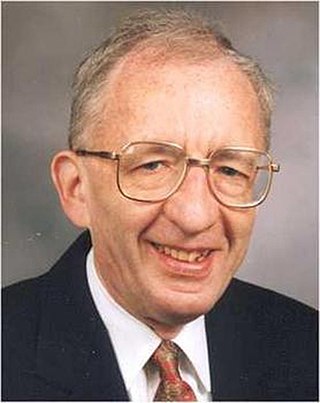Related Research Articles

Algebraic geometry is a branch of mathematics which uses abstract algebraic techniques, mainly from commutative algebra, to solve geometrical problems. Classically, it studies zeros of multivariate polynomials; the modern approach generalizes this in a few different aspects.

In mathematics, a Diophantine equation is an equation, typically a polynomial equation in two or more unknowns with integer coefficients, for which only integer solutions are of interest. A linear Diophantine equation equates to a constant the sum of two or more monomials, each of degree one. An exponential Diophantine equation is one in which unknowns can appear in exponents.

Number theory is a branch of pure mathematics devoted primarily to the study of the integers and arithmetic functions. German mathematician Carl Friedrich Gauss (1777–1855) said, "Mathematics is the queen of the sciences—and number theory is the queen of mathematics." Number theorists study prime numbers as well as the properties of mathematical objects constructed from integers, or defined as generalizations of the integers.
In mathematics, a Diophantine equation is an equation of the form P(x1, ..., xj, y1, ..., yk) = 0 (usually abbreviated P(x, y) = 0) where P(x, y) is a polynomial with integer coefficients, where x1, ..., xj indicate parameters and y1, ..., yk indicate unknowns.
Hilbert's tenth problem is the tenth on the list of mathematical problems that the German mathematician David Hilbert posed in 1900. It is the challenge to provide a general algorithm that, for any given Diophantine equation, can decide whether the equation has a solution with all unknowns taking integer values.

Faltings's theorem is a result in arithmetic geometry, according to which a curve of genus greater than 1 over the field of rational numbers has only finitely many rational points. This was conjectured in 1922 by Louis Mordell, and known as the Mordell conjecture until its 1983 proof by Gerd Faltings. The conjecture was later generalized by replacing by any number field.

Geometry of numbers is the part of number theory which uses geometry for the study of algebraic numbers. Typically, a ring of algebraic integers is viewed as a lattice in and the study of these lattices provides fundamental information on algebraic numbers. The geometry of numbers was initiated by Hermann Minkowski (1910).
In mathematics, the arithmetic of abelian varieties is the study of the number theory of an abelian variety, or a family of abelian varieties. It goes back to the studies of Pierre de Fermat on what are now recognized as elliptic curves; and has become a very substantial area of arithmetic geometry both in terms of results and conjectures. Most of these can be posed for an abelian variety A over a number field K; or more generally.
In mathematics, Helmut Hasse's local–global principle, also known as the Hasse principle, is the idea that one can find an integer solution to an equation by using the Chinese remainder theorem to piece together solutions modulo powers of each different prime number. This is handled by examining the equation in the completions of the rational numbers: the real numbers and the p-adic numbers. A more formal version of the Hasse principle states that certain types of equations have a rational solution if and only if they have a solution in the real numbers and in the p-adic numbers for each prime p.
In mathematics, Diophantine geometry is the study of Diophantine equations by means of powerful methods in algebraic geometry. By the 20th century it became clear for some mathematicians that methods of algebraic geometry are ideal tools to study these equations. Diophantine geometry is part of the broader field of arithmetic geometry.
In mathematics, Roth's theorem or Thue–Siegel–Roth theorem is a fundamental result in diophantine approximation to algebraic numbers. It is of a qualitative type, stating that algebraic numbers cannot have many rational number approximations that are 'very good'. Over half a century, the meaning of very good here was refined by a number of mathematicians, starting with Joseph Liouville in 1844 and continuing with work of Axel Thue (1909), Carl Ludwig Siegel (1921), Freeman Dyson (1947), and Klaus Roth (1955).

John William Scott "Ian" Cassels, FRS was a British mathematician.

In mathematics, arithmetic geometry is roughly the application of techniques from algebraic geometry to problems in number theory. Arithmetic geometry is centered around Diophantine geometry, the study of rational points of algebraic varieties.
This is a glossary of arithmetic and diophantine geometry in mathematics, areas growing out of the traditional study of Diophantine equations to encompass large parts of number theory and algebraic geometry. Much of the theory is in the form of proposed conjectures, which can be related at various levels of generality.
A height function is a function that quantifies the complexity of mathematical objects. In Diophantine geometry, height functions quantify the size of solutions to Diophantine equations and are typically functions from a set of points on algebraic varieties to the real numbers.
In mathematics, Brauer's theorem, named for Richard Brauer, is a result on the representability of 0 by forms over certain fields in sufficiently many variables.
In mathematics, the subspace theorem says that points of small height in projective space lie in a finite number of hyperplanes. It is a result obtained by Wolfgang M. Schmidt (1972).
In mathematics, in the field of algebraic number theory, an S-unit generalises the idea of unit of the ring of integers of the field. Many of the results which hold for units are also valid for S-units.

Alan Baker was an English mathematician, known for his work on effective methods in number theory, in particular those arising from transcendental number theory.
In mathematics, the Tsen rank of a field describes conditions under which a system of polynomial equations must have a solution in the field. The concept is named for C. C. Tsen, who introduced their study in 1936.
References
- ↑ Lekkerkerker, Cornelis Gerrit (1969), Geometry of numbers, Bibliotheca Mathematica, vol. 8, Amsterdam: North-Holland Publishing Co., p. 29, ISBN 9781483259277, MR 0271032 .
- ↑ Bombieri, Enrico; Gubler, Walter (2006), Heights in Diophantine geometry , New Mathematical Monographs, vol. 4, Cambridge University Press, Cambridge, pp. 190–191, doi:10.1017/CBO9780511542879, ISBN 978-0-521-84615-8, MR 2216774 .